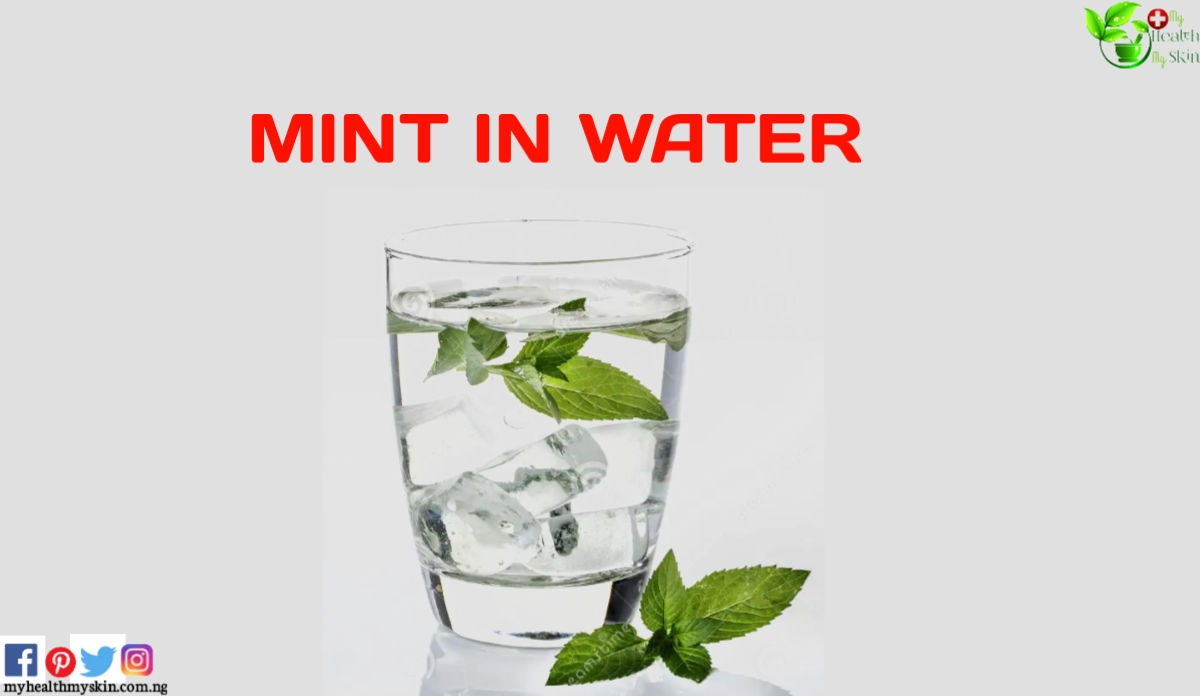Mint is one of the best-known medicinal plants, archeologist have found mint leaves in Egyptian tomb, and it is used by Greek and Romans to relieve pain or purge patient. Forgotten in the west, it only joined the traditional pharmacopoe in the 18th century, and since then it has been one of the first plants to be used intensively by the pharmaceutical industry, making methol a classic.
Pharmacy stores, mint is also found in large number candies, syrup or as a flavour intended to improve the taste of certain medicine. The mint is a very aromatic plant up to 80 cm tall.
It belongs to the lamiaceae family. Its the most used variety in herbal medicine. It has a serrated structure with square stem. Its colour is green and its harvested annually, sown in spring and harvested in summer, and found in Europe, Asia, North America.
Defining Mint water and Understanding What It’s Good for
Mint water is a simple and refreshing drink that offers potential health benefits. It has no sugar, no caffeine, and very few calories. Mint water is an excellent solution if you are looking for a healthy alternative to soda or sugary drinks.
Mint is general term for plants in the genus Mentha. Due to its refreshing taste and distinct calming sensation, mint is commonly used as an ingredient in teas, alcoholic beverages, sauces, desserts, and more.
Mint’s well-liked flavor makes it an excellent ingredient for making your daily drink. Mint water doesn’t just taste great; it’s also good for you. Studies have shown that drinking mint water is beneficial for your health and skin.
How to Make Mint Water
- You can make mint water at home by steeping mint leaves in boiling water.
- Then, chilling to your preferred temperature.
- Mint water is best served in a glass with ice — no mix up required!
What’s in Mint Water? A Closer Look at Its Nutritional Facts
Mint water is a potent source of antioxidants, especially when compared to other herbs and spices. It is also a good source of vitamin A, a fat-soluble vitamin that is critical for eye health and night vision.
Nutritional Facts
Let’s look at nutritional content of mint:
Nutritional content of mint slightly varies across varieties.
One Tablespoon of fresh spearmint contains:
- Calories: 3
- Protein: 0 grams
- Fat: 0 grams
- Carbohydrates: 0 grams
- Fiber: Less than 1 gram
- Sugar: 0 grams
One Tablespoon of fresh peppermint contains:
- Calories: 1
- Protein: 0 grams
- Fat: 0 grams
- Carbohydrates: 0 grams
- Fiber: Less than 1 gram
- Sugar: 0 grams
- Fresh peppermint also contains small amounts of vitamins A and C.
What are the Benefits of Mint leaves in Water?
Mint leaves are great source of vitamins and minerals. Its soothing qualities and lack of sugar and other preservatives make it a healthy and excellent choice for most people. Also, research has found several amazing health benefits of mint leaves in water:
- Clears Bad Breath: Research suggests that mint may help reduce the bacteria within the mouth that causes halitosis. Mint water’s anti-bacterial quality makes it a perfect beverage for freshening your breath throughout the whole day. Drinking of mint water does not replace or reduce the need for regular brushing and flossing.
- Promotes Alertness and Fatigue: As mint water does not contain any caffeine, Research suggests that the aroma of mint can help promote alertness and fight fatigue. Studies also show that the scent of mint may elevate your mood. This makes mint water the excellent choice for an afternoon pick-me-up.
- Soothe Common Cold Symptoms: The menthol quality of mint water has been proven to help clear nasal passages. It can also help soothe some of the symptoms of the common cold. Although mint water has not been shown to cure any illnesses, further research is needed to confirm these findings.
- Supports Digestive Health: Mint has been a folk remedy for upset stomachs for years. Recently, modern science pointed to mint’s effectiveness in supporting digestive health. Mint water is a perfect way to enjoy the digestive benefits of mint. Mint water contains menthol, which some studies have shown may help control irritable bowel syndrome. Research suggests that mint water may help soothe some of the symptoms of IBS. Also studies show that mint can help alleviate dyspepsia (poor digestion).
FAQS
A Look at Some FAQS and Answers About Mint:
What are the Uses Of Mint Leaves?
Mint is often offered in form of industrial or artisanal preparations, such as capsules, lotions, methol creams, tintures, or essential oils, which generally recommended for three times daily. 2-4 drops for dyeing(45%). 2-5 ml at the same frequency should be used. Infusion for better digestion, drink a cup after each meal.
In Infusion; a tablespoon of leaves for 150ml of boiling water. For one liter of water weigh 15 g of leaves. Boil 10 minutes and take 3 to 4 cups daily.
In Gargle; 50 g of dried mint leaves for one liter of a water and boil for 10 minutes.
What aee the Uses Of Mint Leaves For Skin?
The lotion, made from the infusion, is applied to irritated skin.
What Are The Benefits Of Mint Leaves In Tea?
Mint tea can help in so many ways by giving us relieve from bad breath and mental stress. It also helps boost our immune system, resulting to weight loss. Here are some of the benefits of mint leaves in tea;
Promotes Healthy Skin and Hair
Anti-inflammatory compound in mint can help reduce redness caused by acne and antiseptic properties help prevent build up of bacteria that can clog pores. The soothing effects ofmint are useful for treating skin rashes and itchy bug bites.
Like oral products, mint is used in a variety of skin care treatments at salons to promote a healthy scalp.mint can help treat dandruff by reducing itchiness and soothing dry scalps. For best results, wash hair using mint tea and let sit for 5 to 10 minutes before rinsing.
Reduces Fever
Drinking a hot cup of mint tea induces sweating, which is the body’s natural way of cooling down. The extra fluids also encourage detoxification so your body can eliminate the cause of your cold, flu and fever.
One of the main ingredients in mint tea is menthol, which has been shown to help break a fever. At the same time, the menthol works internally to decrease temperature thus bringing down your fever. Menthol is also a natural muscle relaxant so it helps to alleviate the aches and pains that come along with high fevers.
Essential Oils
When you steep your fresh mint leaves in a hot water, essential oils are released and this process gives the herbal tea it’s refreshing taste. Essential oils are antiviral and antimicrobial, and this can benefit your immune system and also help fight infection.
Prevents Nausea
Mint tea has antispasmodic properties that can treat the feelings of nausea and prevent vomiting. The scent of mint can inhibit feelings of nausea while organic compounds in the mint help to soothe stomach muscles that contract and lead to vomiting. Drinking peppermint tea before boarding a plane, boat or while onboard a boat can help to cure the feelings of motion sickness or seasickness.
How did you like this post? Let us know by commenting in the box below!







